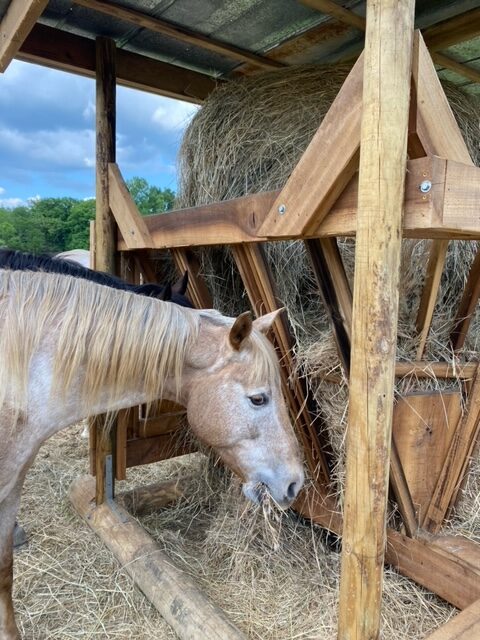Our Horse Track

The Inspiration
A man by the name of Jaime Jackson conducted a study on how wild horses survive and thrive in their natural environments. Through months of following a herd of wild horses, Jaime observed several key factors that contributed to the health and durability of the mustangs. On an average day, the herd would travel 25-30 miles; the wild horses covered miles of rugged terrain in order to gain access to all of the resources that they needed for survival. After a few weeks, Jackson noticed that the horses would travel the same path between resources which he refers to as tracks.
According to Jaime Jackson’s book, Paddock Paradise, the mustangs remembered where they could get food, water, shelter, and minerals. Due to the varied terrain throughout the track, they developed strong, hardened hooves to sustain the miles traveled. Along the path to the herd’s essential resources, the horses would stop to fulfill less essential needs such as dust bathing, scratching, browsing, and loafing. All of the traveling between resources forced the wild horses to be incredibly healthy and agile.
The Past
For many years, Wears Valley Ranch managed their horses like beef cattle – constantly moving the herd to fresh, lush pastures. Managing the herd in this way resulted in the horses gaining excess weight, and a couple of horses developed or increased in some health problems. One horse in particular dealt with a bad bout of Laminitis, which occurs when a horse consumes too much sugar. The horse was in extreme pain as it’s nail bed became inflamed, allowing his hoof bone to rotate. These horses generally already have a history of a metabolic disorder that leads to the excess sugar causing inflammation in their body. In order for this horse to recover and live well the rest of his life, we knew that we had to manage our herd differently.
The Present
Since February of 2022, the WVR herd has lived on a track system, inspired by Jaime Jackson’s book, Paddock Paradise. The equestrian staff designated one pasture to the new management of the herd and set up a track around the perimeter of the field with an alleyway to the barn’s catch pen. In the catch pen, the horses have access to shelter and water, and along the track, the horses can find varied terrain, hay, shade for loafing, browsing, and minerals. As time allows, the track will be filled with other amenities such as a place to dust bathe and environmental enrichment objects.

The Track Aspects
- Hay: WVR horses consume their daily requirement of roughage in the form of hay. Hay is dried grass which reduces the amount of sugar that the horses are consuming.
- Water: Horses can drink more than 10 gallons of water a day, and water is essential for them to be able to digest the hay that they have eaten.
- Salt & Minerals: Our horses have free choice access to a mix of loose salt and minerals in order to ensure that their nutritional needs are met.
- Logs: Large logs provide an opportunity for the horses to stretch while walking over them or weaving between them.
- Textured surfaces: Varied terrain impacts the horses hooves by helping the hooves harden and helps round off some jagged edges between trims.
- Movement: Just like people, horses need diet and exercise in order to be healthy. Movement not only encourages weight loss for our horses, it also increases the blood supply to the horses hooves, allowing for more healthy hoof growth.
- Playtime: The horses are turned out into our large arena 5 days a week; this allows them to have an open space to run and sort out herd dynamics.
The Benefits
In the first couple of months that the WVR herd lived on the track, the equestrian staff saw all of the horses lose weight and begin to look fit. One of the older, arthritic horses began to move as if he was 5 years younger and had an increased amount of power in his stride. Several other horses seem to be more mentally content and ready to work. In lessons, the horses are performing better and showing increased stamina. Our farrier noticed increased hoof growth and hardness when he was came for the routine hoof maintenance. Instead of concentrating manure near the barn, it is distributed around the track where the chickens scratch through the manure to eat insect larvae and to spread out the piles, allowing them to decompose and turn into soil more quickly.
The Future
The long term goal of the track is for our horses to live long, healthy, productive lives where they can serve our students well. Additionally, putting the horses on the track opened up around 8 acres of pasture land which we hope to manage in a way that will allow our grass-fed, grass-finished beef and lamb to have access to more fresh forage.
